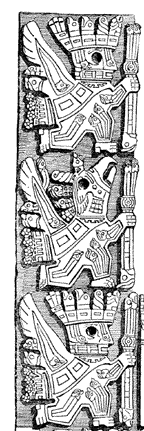Athena Review Image Archive ™
Tiahuanaco: the Gateway of the Sun
Winged figures on the Gateway of the Sun (Squier 1877).
Tiahuanaco,
located on Lake Titicaca in Bolivia, was a major religious center of
the Huari-Tiahuanaco empire. During the Middle Horizon (AD 600-1000),
the Huari military organization dominated the Peruvian Andes, and
eventually linked up with the formidable priestly apparatus at
Tiahuanaco to create a powerful theocratic state.
The
symbolic relief carvings on the Gateway of the Sun at Tiahuanaco, often
strikingly well-preserved in slabs of volcanic andesite, were first
reported in detail by Ephriam G. Squier in his 1877 book, Incidents of Travel and Exploration in the Land of the Incas.
Squier
describes the tiers of winged condor-headed and human-headed figures
kneeling toward the central sun god figure "as if in adoration, each
one holds before him a staff or sceptre..." These winged figures
represent the heads of condors, tigers, and serpents. The central
figure in the Sun Gateway, holding a pair of staffs, is probably linked
to the much earlier Chavin Staff God (from ca. 800-300 BC).
Squier
also notes that the islands of Lake Titicaca were traditionally thought
to have produced the founders of the Inca Empire. This appears to be
upheld by modern archaeology, which shows that during the
Huari-Tiahauanaco period, centralized state organization occurred with
regional storehouses, roads, and redistribution of resources and local
populations, all preceding the much better documented Inca empire by
hundreds of years.
Copyright © 1996-2019 Rust Family Foundation (All Rights Reserved).
